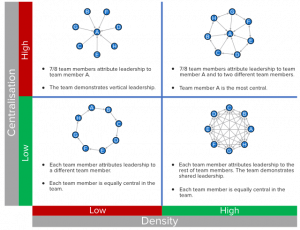WHAT IS SHARED LEADERSHIP?
Leadership is a process of social influence, which supports team members to achieve a goal. Leadership stems from social influence, not authority or power.
Shared Leadership, or distributed leadership, are terms used today to describe the team phenomenon whereby leadership roles and influence are distributed among team members.
In contrast to vertical leadership models, where a single individual takes the leadership role, shared leadership relies on the team as a whole. This means that every team member is empowered to assume leadership in the team. Leadership that is shared in a team can be enacted by any of the team members at different times. These team members can be, but are not necessarily, the formally appointed leader of the team.
WHY IS SHARED LEADERSHIP IMPORTANT?
Teams demonstrating shared leadership improve their performance in a diverse range of team outcomes such as team creativity and team satisfaction. This is because, among other things, when members of a team provide leadership to each other they exchange and share more information, experience higher commitment, and become more responsible for decision-making.
WHERE CAN I LEARN MORE ABOUT SHARED LEADERSHIP?
There are a wide variety of sources to learn more about shared leadership. Below we cite some of our favourites.
Academic Articles
- Flow experience in teams: The role of shared leadership.
- Shared leadership in teams: An investigation of antecedent conditions and performance.
- The emergence of shared leadership in newly formed teams with an initial structure of vertical leadership.
- Social networks and the performance of individuals and groups.
Online articles / Publications
- How shared leadership changes our relationships at work.
- Bye bye heroic leadership here comes shared leadership.
Books

HOW IS SHARED LEADERSHIP MEASURED IN TEAMSCAN?
In TeamScan, shared leadership is measured by using a social network analysis (SNA) approach. This approach consists of measuring the extent to which team members have influence in the team.
HOW IS SHARED LEADERSHIP CALCULATED IN TEAMSCAN?
In TeamScan, shared leadership is calculated with density and centralisation.
Density
- Density refers to the amount of leadership (influence) shown by team members (as perceived by other team members).
- Within the context of shared leadership, density indicates the extent to which team members perceive other team members as influential.
- Density ranges from 0% to 100%. A score of 100% represents a team in which each team member perceives every colleague as very influential, while a score of 0% characterises a team in which each team member does NOT perceive any of their colleagues as very influential.
Centralisation
- Centralisation indicates the distribution of leadership (influence) among the members of a team.
- Within the context of shared leadership, centralisation reflects the extent to which leadership in a team is concentrated on a single person.
- Centralisation ranges from 0% to 100%. A score of 100% indicates that leadership is concentrated around a single individual, thereby signifying vertical leadership and not shared leadership. The lower the score on centralisation, the higher the degree of shared leadership in the team. Thus a score of 0% indicates that leadership is distributed among team members.
Density and Centralisation in a leadership network
Below you can find a matrix with density and centralisation as its dimensions. The leadership network in each quadrant is a graphical representation of a team’s density and centralisation scores.
As mentioned before, the scores of these measures will depend on how team members perceive their colleagues’ influence in the team. Ideally, a team that aims to demonstrate shared leadership will present a low centralisation score and a high density score. In concrete terms, a team with high shared leadership will have as many arrows pointing to as many team members as possible.

HOW CAN I START FOSTERING SHARED LEADERSHIP IN MY TEAM?
Research shows that there are many variables contributing to the emergence of shared leadership in teams. Two of the most acknowledged variables are internal team environment and vertical empowering leadership.
Internal team environment consists of team members who have a similar (or collective) understanding of objectives, who provide psychological safety to each other, and who actively participate in the decision making of the team.
Vertical empowering leadership originates in the formally appointed team leader. It is characterised by an empowering leadership style in which self-management and/or self-leadership skills are promoted.
In order to foster shared leadership in your team, focus on developing internal team environment and empowering leadership behaviours. Here are key action points to develop these two variables:
Internal team environment
- Foster psychological safety in your team.
- Stimulate the team to voice their thoughts, spurring their willingness to speak up in the workplace.
- Discuss with the team the goals of the team and make sure everyone shares an understanding of them.
Vertical empowering leadership
- Lead by example.
- Show that you care.
- Coach team members.
- Allocate more autonomy and responsibilities to team members.
